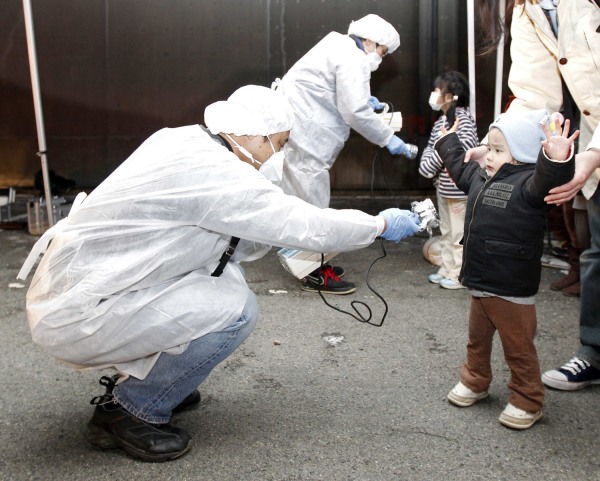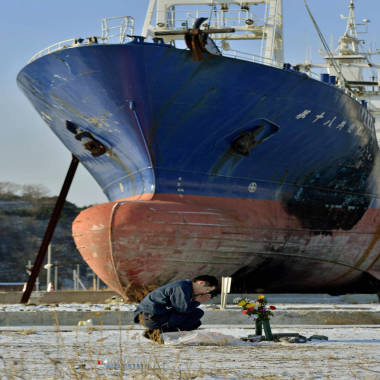Opmmur
Time Travel Professor
- Messages
- 5,049
Fukushima evacuation has killed more than earthquake and tsunami, survey says
The Link: Fukushima evacuation has killed more than earthquake and tsunami, survey says - World News

Kim Kyung-Hoon / Reuters file
Officials in protective gear check for signs of radiation on children who are from the evacuation area near the Fukushima Daini nuclear plant in Koriyama, in March 2011.
By Alexander Smith, NBC News contributor
More people have now died because of the Fukushima evacuation process than were killed in the region by the 2011 Japanese earthquake and tsunami which caused the displacement, a survey said.
Some 300,000 people evacuated their homes in the prefecture after the disaster caused multiple meltdowns at the Fukushima Daiichi nuclear plant, according to Red Cross figures.
A survey by popular Japanese newspaper Mainichi Shimbun said Monday that deaths relating to this displacement – around 1,600 – have surpassed the number killed in the region in the original disaster.
Close to 16,000 people were killed across Japan as a direct result of the earthquake and tsunami in 2011. According to the Mainichi report, 1,599 of these deaths were in the Fukushima Prefecture.
Causes of death in the aftermath have included “fatigue” due to conditions in evacuation centers, exhaustion from relocating, and illness resulting from hospital closures. The survey also said a number of suicides had been attributed to the ordeal.
Francis Markus, East Asia spokesperson for the International Federation of Red Cross and Red Crescent Societies (IFRC), said the conditions faced by those displaced is made worse by them not knowing when they can return.
“What we are seeing is some very, very difficult social and emotional effects that communities are having to cope with,” he said Tuesday. “A lot of the people suffering are the older generation, and they need a lot of support to make it through with as little ill effect as possible. It's a very serious and painful existence.”
Markus has visited many of the evacuees as part of the IFRC relief efforts in the region.

A man prays as he mourns victims of the 2011 earthquake and tsunami as a ship brought ashore by the disaster is seen in the background, in Kesennuma, Japan, in March this year.
“You drive into the settlements and find they are very neat and tidy,” he said.
“There is a car park, and then there is rows upon rows of these very neat but very small prefabricated houses, each with a family trying to make them as homely as possible. In the summer they are very hot and in the winter they are very chilly.
"People from the worst affected areas are really very concerned as to when they will be able to go back, if they will be able to go back at all."
The Mainichi newspaper said it surveyed 25 towns and villages in the prefecture, as well as taking into account "condolence money” applications for at least 109 people reportedly killed in relation to the evacuation. Figures by Japan's Reconstruction Agency in March put the total number of these deaths at 1,383.
Tepco, the company which runs the crippled Fukushima plant, came under increased scrutiny after it admitted last month 300 tons of highly radioactive water leaked from one of the hastily built tanks storing contaminated water at the site, according to a Reuters report Tuesday.
Prime Minister Shinzo Abe’s government last week pledged nearly half a billion dollars to contain the site’s contaminated water, including the construction of a subterranean ice wall.
Abe, speaking from Buenos Aires where it was announced Tokyo had successfully won its bid to host the 2020 Olympic Games, said the issue is “under control.”
Reuters contributed to this report.
Related:
The Link: Fukushima evacuation has killed more than earthquake and tsunami, survey says - World News

Kim Kyung-Hoon / Reuters file
Officials in protective gear check for signs of radiation on children who are from the evacuation area near the Fukushima Daini nuclear plant in Koriyama, in March 2011.
By Alexander Smith, NBC News contributor
More people have now died because of the Fukushima evacuation process than were killed in the region by the 2011 Japanese earthquake and tsunami which caused the displacement, a survey said.
Some 300,000 people evacuated their homes in the prefecture after the disaster caused multiple meltdowns at the Fukushima Daiichi nuclear plant, according to Red Cross figures.
A survey by popular Japanese newspaper Mainichi Shimbun said Monday that deaths relating to this displacement – around 1,600 – have surpassed the number killed in the region in the original disaster.
Close to 16,000 people were killed across Japan as a direct result of the earthquake and tsunami in 2011. According to the Mainichi report, 1,599 of these deaths were in the Fukushima Prefecture.
Causes of death in the aftermath have included “fatigue” due to conditions in evacuation centers, exhaustion from relocating, and illness resulting from hospital closures. The survey also said a number of suicides had been attributed to the ordeal.
Francis Markus, East Asia spokesperson for the International Federation of Red Cross and Red Crescent Societies (IFRC), said the conditions faced by those displaced is made worse by them not knowing when they can return.
“What we are seeing is some very, very difficult social and emotional effects that communities are having to cope with,” he said Tuesday. “A lot of the people suffering are the older generation, and they need a lot of support to make it through with as little ill effect as possible. It's a very serious and painful existence.”
Markus has visited many of the evacuees as part of the IFRC relief efforts in the region.

A man prays as he mourns victims of the 2011 earthquake and tsunami as a ship brought ashore by the disaster is seen in the background, in Kesennuma, Japan, in March this year.
“You drive into the settlements and find they are very neat and tidy,” he said.
“There is a car park, and then there is rows upon rows of these very neat but very small prefabricated houses, each with a family trying to make them as homely as possible. In the summer they are very hot and in the winter they are very chilly.
"People from the worst affected areas are really very concerned as to when they will be able to go back, if they will be able to go back at all."
The Mainichi newspaper said it surveyed 25 towns and villages in the prefecture, as well as taking into account "condolence money” applications for at least 109 people reportedly killed in relation to the evacuation. Figures by Japan's Reconstruction Agency in March put the total number of these deaths at 1,383.
Tepco, the company which runs the crippled Fukushima plant, came under increased scrutiny after it admitted last month 300 tons of highly radioactive water leaked from one of the hastily built tanks storing contaminated water at the site, according to a Reuters report Tuesday.
Prime Minister Shinzo Abe’s government last week pledged nearly half a billion dollars to contain the site’s contaminated water, including the construction of a subterranean ice wall.
Abe, speaking from Buenos Aires where it was announced Tokyo had successfully won its bid to host the 2020 Olympic Games, said the issue is “under control.”
Reuters contributed to this report.
Related:







